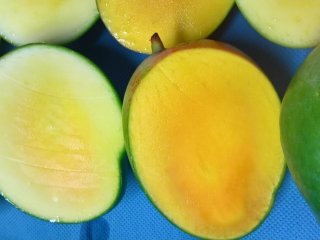
Research Results
Using NIR to find defects in mangoes
In GreenCHAINge an innovative “smart chain” is being developed. Overall goal is to improve the intrinsic quality of the product on the shelf. One of the challenges is to perform non-destructive measurements to determine product quality.

Objective
The objective of this study was to obtain uniform and RTE (Ready to Eat) mangos on the shelf, and to compare and predict “defected” versus “healthy” mangos using non- destructive NIR (Near-infrared) measurements.
Experiment and results
Non-destructive NIR measurements using a FELIX-F750 handheld on approximately 100 “defected” mangos (with internal defects) and 100 “healthy” mangos, indicates that the NIR spectra can be divided in two separate classes.
Mangos can be classified as “defected” or “healthy”, based on their NIR spectrum, with an accuracy of 86% and standard dev. of 4%.
A mango predicted as defected according to the NIR spectrum is truly defected 87% of the time.
A mango predicted as healthy according to the NIR spectrum is truly healthy 84% of the time.

NIR spectra from defected (green) and healthy (blue) mangos, showing a distinction in two groups.
Conclusion
Measuring NIR spectra allows us to predict internal defects in a non-destructive way. The experiment performed showed that by analyzing differences in NIR spectra, mangos could be classified in “defected” or “healthy” fruit, with an accuracy of 86%.